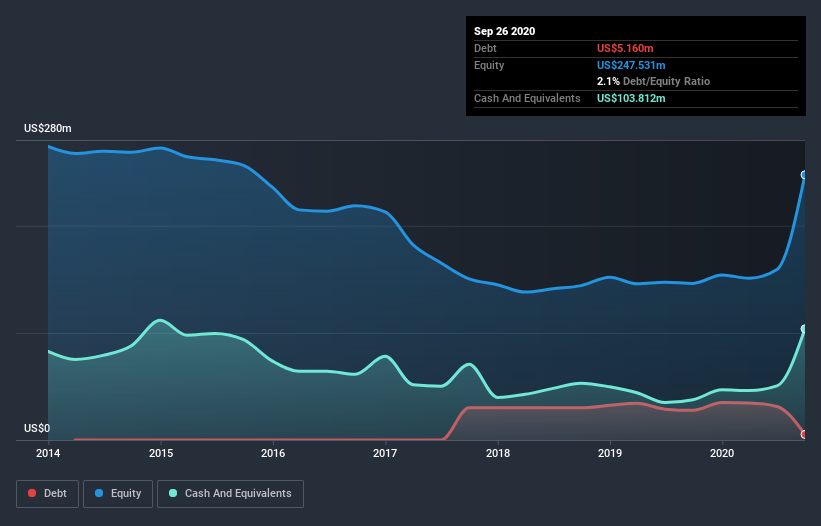These 4 Measures Indicate That Calix (NYSE:CALX) Is Using Debt Safely
Legendary fund manager Li Lu (who Charlie Munger backed) once said, 'The biggest investment risk is not the volatility of prices, but whether you will suffer a permanent loss of capital.' It's only natural to consider a company's balance sheet when you examine how risky it is, since debt is often involved when a business collapses. As with many other companies Calix, Inc. (NYSE:CALX) makes use of debt. But is this debt a concern to shareholders?
What Risk Does Debt Bring?
Debt assists a business until the business has trouble paying it off, either with new capital or with free cash flow. Part and parcel of capitalism is the process of 'creative destruction' where failed businesses are mercilessly liquidated by their bankers. However, a more common (but still painful) scenario is that it has to raise new equity capital at a low price, thus permanently diluting shareholders. Of course, debt can be an important tool in businesses, particularly capital heavy businesses. The first step when considering a company's debt levels is to consider its cash and debt together.
View our latest analysis for Calix
How Much Debt Does Calix Carry?
You can click the graphic below for the historical numbers, but it shows that Calix had US$5.16m of debt in September 2020, down from US$27.7m, one year before. But on the other hand it also has US$103.8m in cash, leading to a US$98.7m net cash position.
A Look At Calix's Liabilities
We can see from the most recent balance sheet that Calix had liabilities of US$92.7m falling due within a year, and liabilities of US$45.1m due beyond that. Offsetting these obligations, it had cash of US$103.8m as well as receivables valued at US$69.1m due within 12 months. So it actually has US$35.1m more liquid assets than total liabilities.
Having regard to Calix's size, it seems that its liquid assets are well balanced with its total liabilities. So it's very unlikely that the US$1.86b company is short on cash, but still worth keeping an eye on the balance sheet. Simply put, the fact that Calix has more cash than debt is arguably a good indication that it can manage its debt safely.
Although Calix made a loss at the EBIT level, last year, it was also good to see that it generated US$20m in EBIT over the last twelve months. There's no doubt that we learn most about debt from the balance sheet. But ultimately the future profitability of the business will decide if Calix can strengthen its balance sheet over time. So if you're focused on the future you can check out this free report showing analyst profit forecasts.
But our final consideration is also important, because a company cannot pay debt with paper profits; it needs cold hard cash. Calix may have net cash on the balance sheet, but it is still interesting to look at how well the business converts its earnings before interest and tax (EBIT) to free cash flow, because that will influence both its need for, and its capacity to manage debt. Over the most recent year, Calix recorded free cash flow worth 75% of its EBIT, which is around normal, given free cash flow excludes interest and tax. This free cash flow puts the company in a good position to pay down debt, when appropriate.
Summing up
While it is always sensible to investigate a company's debt, in this case Calix has US$98.7m in net cash and a decent-looking balance sheet. The cherry on top was that in converted 75% of that EBIT to free cash flow, bringing in US$15m. So we don't think Calix's use of debt is risky. When analysing debt levels, the balance sheet is the obvious place to start. But ultimately, every company can contain risks that exist outside of the balance sheet. Be aware that Calix is showing 4 warning signs in our investment analysis , you should know about...
At the end of the day, it's often better to focus on companies that are free from net debt. You can access our special list of such companies (all with a track record of profit growth). It's free.
This article by Simply Wall St is general in nature. It does not constitute a recommendation to buy or sell any stock, and does not take account of your objectives, or your financial situation. We aim to bring you long-term focused analysis driven by fundamental data. Note that our analysis may not factor in the latest price-sensitive company announcements or qualitative material. Simply Wall St has no position in any stocks mentioned.
Have feedback on this article? Concerned about the content? Get in touch with us directly. Alternatively, email editorial-team (at) simplywallst.com.

